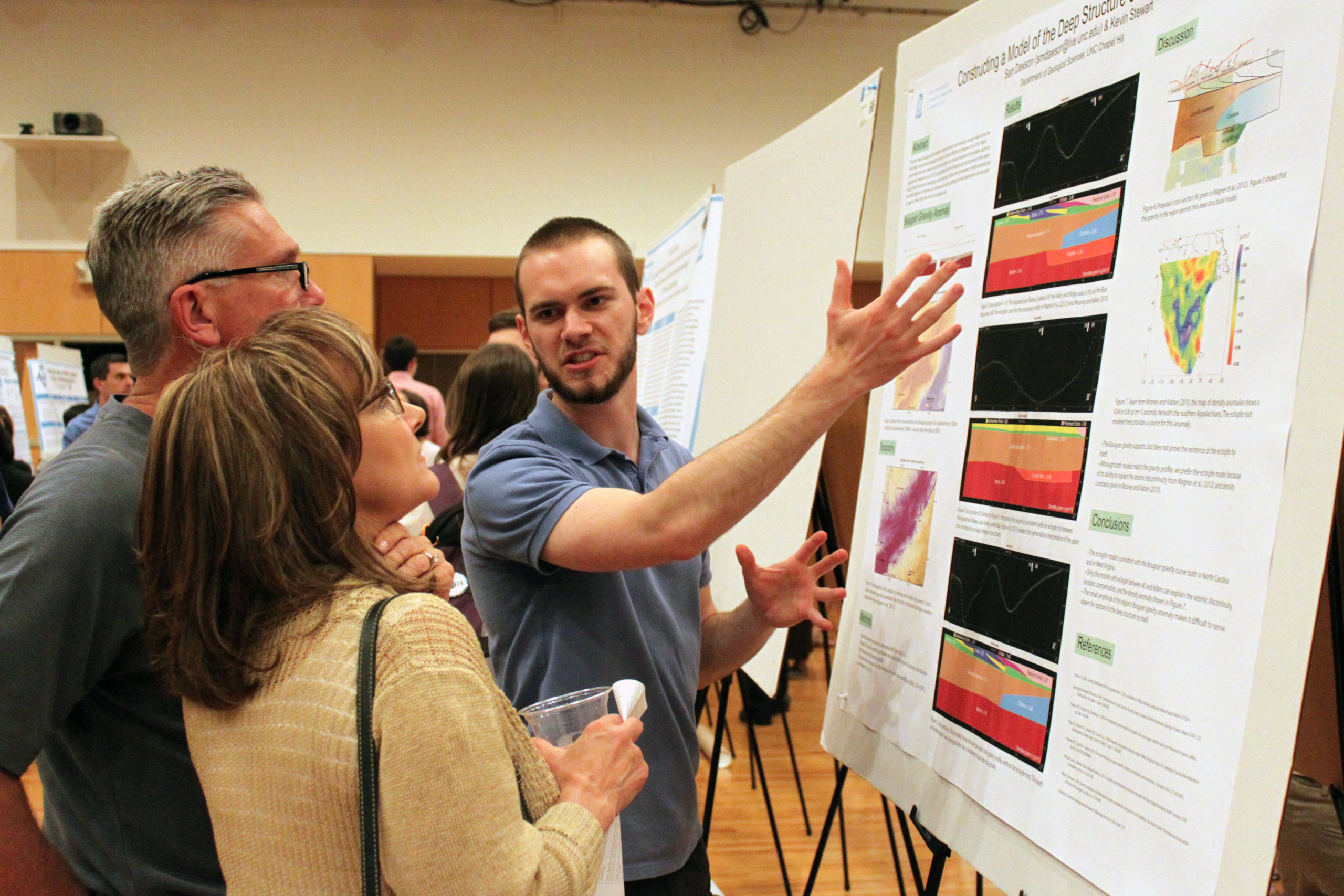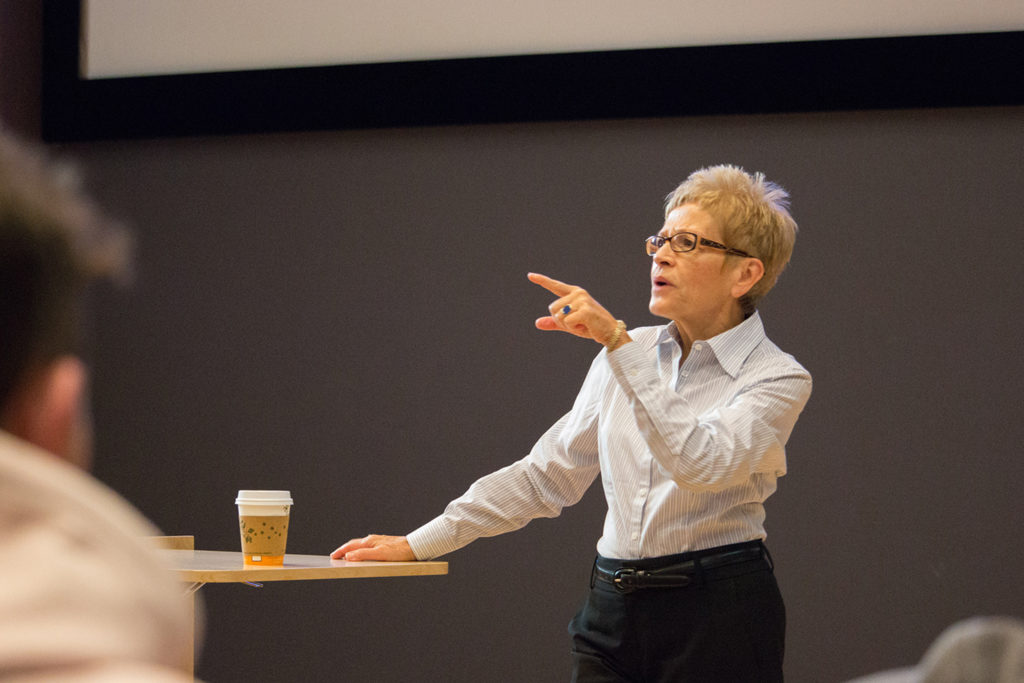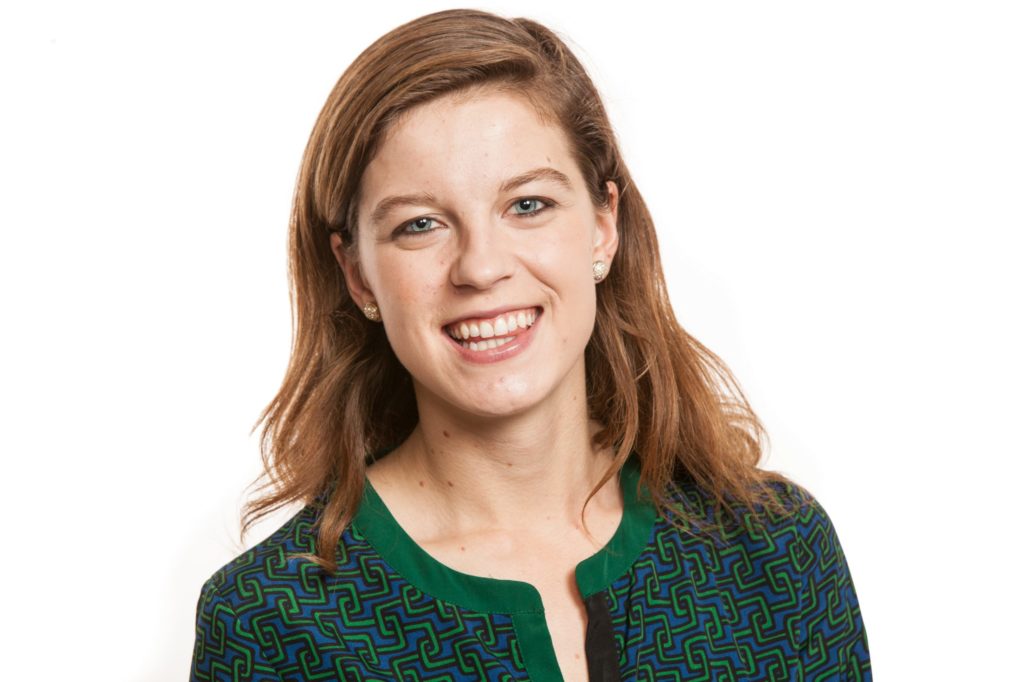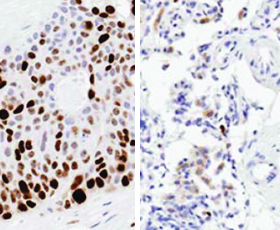
After months of data analysis, literature reviews, interviews and testing, more than 140 Carolina students presented their research findings Monday at the 15th annual Celebration of Undergraduate Research at the Frank Porter Graham Student Union.
“For undergraduates, this celebration is a great time to publicize and share their research, whether in a talk or poster format,” said Donna Bickford, associate director for Undergraduate Research in the College of Arts and Sciences. “The symposium represents research that comes from a variety of disciplines, from biology to economics to art history, and is a true testament to the mentorship opportunities available to undergraduates at Carolina.”
The event gave the students a chance to explain their research methods and findings to faculty members, fellow students, family and visitors who came to the celebration in the Great Hall. For many, the event marked the first time they had to condense their work to fit on a poster and present their research results in a short presentation to the general public.
“For me, it’s just getting the opportunity to practice presenting in an environment like this,” said Amanda Kramer, a psychology major who studied how implicit goals of positivity can affect a person’s mood. “I’ve never done a poster presentation before, so to be able to see what it looks like before launching into a more professional environment has been really helpful.”

Lines of students stood in front of their posters and answered general questions from the public about their research. More than 100 students presented their findings. Among them:
- Aya Avishai-Yitshak, a senior from Asheville, who worked with psychology doctoral student Kathryn Adair and professor Barbara Fredrickson on a study of Mindfulness and Time Perception. “We had been working on mindfulness, and noticed there wasn’t much research on time perception,’’ Avishai-Yitshak said. “We found that people more present and more focused on what they were doing had a longer perception of time – like the time is stretching. It’s called time affluence or feeling a wealth of time. You could take it one step further and do research on how people with increased mindfulness and time affluence feel.”
- Senior history major Grace Tatter, whose poster presentation was based on her 100-page honors thesis about race and equality in Chapel Hill-Carrboro City Schools since desegregation. “I didn’t think that I could talk about it succinctly or put it all on one poster. Having to articulate it in kind of a quick elevator pitch to people who walk by, I think that has given me confidence that I did understand my research because I can distill it and translate to people who haven’t read the 100-page thesis.”
- Daniel Portner, a senior geology major from Olney, Md., who first thought about his research during discussions about hydro-fracking. He wound up focusing his study on the Triassic Deep River Basin in North Carolina where there seemed to be no seismic activity, especially when compared to South Carolina and Virginia. Porter, under the direction of professor Lara Wagner, set up seismometers in an area that runs south of Durham and through the Sanford area from March 2012 to July 2013. All of the activity of 0.9 magnitudes or above came from quarry blasts Monday through Friday, showing that there truly is a seismic gap in central North Carolina. If hydro-fracking does occur in the area, researchers may be able to shed light on whether fracking causes seismic activity.
- Senior biology major Marwa Elnagheeb, who, along with the lab of UNC epidemiologist Carla Cerami, started researching a strange thing that aid workers noticed in sub-Saharan Africa. “People who were receiving iron supplements had a higher risk of malaria,” Elnagheeb said. In other words, a supplement that was supposed to help the health and brain development of children was in some ways hurting. “Malaria infects liver cells first,” Elnagheeb said. “Once the liver cells rupture, it enters red blood cells. The time the parasite spends in the red blood cells—that’s what causes the symptoms of malaria, the lethargy, fever, and chills.” Marwa and the Cerami lab used red blood cells from UNC Hospitals patients, cultured the cells with the parasite that causes malaria, and found that the parasite can’t get inside iron-deficient cells as easily. When it does get inside, it develops normally, but can’t replicate as easily as in cells with plenty of iron.
- Rachel Johnson, an art major, who presented her research, “Life Guard: A Documentary Film Exploration of Water as a Public Space,” in a platform session at the symposium. She interspersed her talk with photos and a film clip. Her adviser was Sabine Gruffat, assistant professor in the art department. Through documentary film, she investigated the importance of public pools to the diversity of members of a community in Greensboro, N.C., seeking to define the role of water as a public space. She wanted to understand how it affected people when small neighborhood pools were closed. She collected more than 30 hours of footage for her project, and a Summer Undergraduate Research Fellowship (SURF) helped make the research possible. “My SURF funding gave me the opportunity to shoot my first full-length documentary,” Johnson said. “It has spring-boarded me into the creation of more mature works and has given me the opportunity to explore what aspects of filmmaking interest me most.” She will finish editing the project over the summer, and hopes to submit it to some film festivals.
- Emily Palmer, a journalism and mass communication major, traveled to England to research her project, “200 Years of Pemberley,” done under the guidance of Inger Brodey in English and comparative literature. The 200th anniversary of Jane Austen’s “Pride and Prejudice” gave her an excuse to closely examine the stark contrasts between the modest depictions of Mr. Darcy’s Pemberley estate in the book and the grandiose depictions in different film and TV adaptations, in 1940, 1980, 1995 and 2005. Palmer visited several of the British estates featured in the films, with the help of a SURF grant and found “increasingly exaggerated levels of grandeur” in the estates that were used over the years. Being on the ground in England allowed her to connect with screenwriters and directors of the films. She interviewed Simon Langton after meeting him at a writer’s conference. He was the director of the 1995 BBC mini-series version that starred Colin Firth and Jennifer Ehle, and he discussed production and how that influenced film location.
- Jonathan Perdomo, a biology major,who examined shells in order to date ancient shorelines and determine changes in sea level, under the guidance of geological sciences professor Drew Coleman. Perdomo said he loved doing undergraduate research. “It was a great learning experience for me. I want to apply to graduate school because I want to continue to do research.”
The students represented research from a range of disciplines, including biology; chemistry; applied sciences; environmental science; mathematical sciences; psychology; English and comparative literature; global studies; geology; history; health policy and administration; history; women’s studies; public policy; exercise and sports science; economics; linguistics; and psychology. More than 130 faculty mentors were involved in the undergraduate projects presented at the celebration, which was sponsored by the Office for Undergraduate Research in UNC’s College of Arts and Sciences and The Roosevelt Institute.
Deborah Lee, a senior from Fayetteville, N.C., whose research was with professor Patrick Sullivan in the genetics department, said the celebration was the perfect way to wrap up her biology degree before she graduates in May. “What better way to finish up?”
By Scott Jared, Kim Spurr, Susan Hardy, Thania Benios and Natalie Vizuete.



